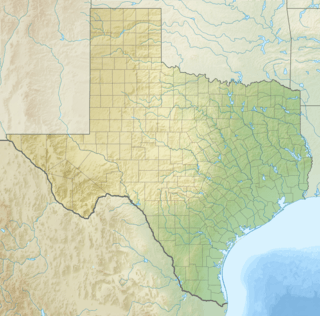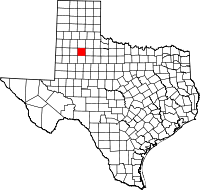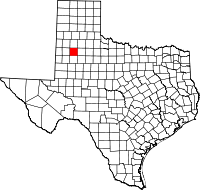Estacado, Texas
| Estacado, Texas | |
|---|---|
|
Abandoned church in Estacado, Texas. | |
 Estacado  Estacado | |
| Coordinates: 33°45′08″N 101°33′43″W / 33.75222°N 101.56194°WCoordinates: 33°45′08″N 101°33′43″W / 33.75222°N 101.56194°W | |
| Country | United States |
| State | Texas |
| Counties | Crosby, Lubbock |
| Elevation[1] | 3,199 ft (975 m) |
| Time zone | Central (CST) (UTC-6) |
| • Summer (DST) | CDT (UTC-5) |
| Area code(s) | 806 |
| FIPS code | 48-24612[2] |
| GNIS feature ID | 1373675[3] |
| Website | Handbook of Texas |
Estacado is a ghost town in Crosby and Lubbock counties in the U.S. state of Texas. Located along Farm to Market Road 1527, it was established in 1879 as a Religious Society of Friends (Quaker) colony by Paris Cox and originally named Maryetta after his wife. In 1886, it became the first government seat of Crosby County. In 1936, Recorded Texas Historic Landmark number 4779 was designated to commemorate the founding of Estacado.[4]
Paris Cox
Paris Cox (1846–1888) was born one of six children in a devout Religious Society of Friends family near Asheboro, North Carolina.[5] During the Civil War, Cox was given a legal exemption from military service, based on the Quaker precept of pacifism.[6]
As treasurer of the North Carolina fellowship of Quakers, Cox was instrumental in helping the Religious Society of Friends, known as Quakers, find a favorable location for both farming and freedom from religious persecution. Their first move from North Carolina was to Indiana.[5] Cox married Mary C. Ferguson during the sojourn in Westfield, Indiana.
After some investigation, Cox purchased several thousand acres in Texas in 1877 and 1878, at twenty-five cents an acre. He first saw the Llano Estacado in 1878 when guided by buffalo hunters. There he met local rancher Henry Clay Smith.[7] Cox arranged for Smith to plant experimental crops on some acreage and send the results to Cox in Indiana.[8]
Establishment
During the winter of 1879, the first white agricultural settlers began to move into the Texas south plains. The first families were named Cox, Stubbs, Spray and Hayworth. Paris Cox first named the area Maryetta (or Marietta) after his wife. Cox had the only real home when he built a sod house. The other families were ill-prepared for the harsh winter months, and only had tents for living quarters. With the spring thaw, the original colonists deserted the area. Only the Cox family remained.[9]
Determined to succeed, Cox stayed and eventually brought in a successful crop. Dr. William Hunt, who would become Postmaster in 1884, visited the area and later wrote:
I visited the colony in August and September 1880. The first crops ever planted on the Staked Plains were then growing. I saw corn, oats, millet, sorghum, melons, Irish potatoes, sweet potatoes and garden vegetables — all did well.— Dr. William Hunt, [5]
The colony began to be repopulated by new families in 1881.[9]
In 1886, Crosby County was organized, and Estacado became the county seat. In 1888, $10,000 in bonds was issued to erect a courthouse.[10] The town flourished for some years, and by 1890 the population was reported at 200.[11]
Post office
A post office was established in 1881, with George W. Singer as postmaster. The town name was changed from Maryetta to Estacaddo. In 1884, the spelling was changed to Estacado. The last Estacado postmaster was John A. Eaves, when, on September 24, 1918, the post office was discontinued and mail service routed to Petersburg.[12]
Education
The Quakers established Crosby County's first education system in 1882, when Emma Hunt taught six students in a sod dugout. Two years later, the classes moved to the Quaker meeting house and the students were given patent desks. The year 1886 saw two teachers earning $45 a month to instruct thirty-two students. In 1889, the Quakers established the Central Plains Academy, with the Harvard University and Johns Hopkins University educated Rev. Jesse Moore as president of the college. Mrs. Moore, who also had a degree from Johns Hopkins University, taught music, voice and violin classes. E.C. and Elva Lewis, graduates of William Penn University, were additional instructors at the college. The twenty-by-sixty-foot frame building held 100 students at its peak. Eighteen students graduated from the college before a dwindling community population caused it to close in 1893.[13]
New county seat and decline
Paris Cox died of throat cancer in 1888, and was buried at Estacado Cemetery.[14]
Estacado store owners R. L. Stringfellow and H. E. Hume founded the Crosby County town of Emma in 1890.[15] The new settlements began to attract Estacado residents who had been discouraged by harsh environmental conditions. On October 14, 1891, a county-wide election was held on where the county seat should be located. Estacado lost to Emma by only six votes. The Estacado courthouse building was moved to Emma, and much of the population along with it.[11]
Estacado continued to suffer. The Quakers moved elsewhere. In the early part of the 20th Century, the population again saw an increase, but never again saw as many residents as it had in 1890.[9]
-

State historical marker erected in 1936 to mark the site of Estacado
-

Estacado Cemetery
See also
References
- ↑ "Estacado". Geographic Names Information System. United States Geological Survey.
- ↑ "American FactFinder". United States Census Bureau. Retrieved 2011-05-14.
- ↑ "US Board on Geographic Names". United States Geological Survey. 2007-10-25. Retrieved 2008-01-31.
- ↑ "THC-Estacado Marker". Recorded Texas Historic Landmark. Texas Historical Commission. Retrieved 19 February 2011.
- 1 2 3 Baker, T. Lindsay (1991). Ghost Towns of Texas. University of Oklahoma Press. pp. 40, 41, 42. ISBN 978-0-8061-2189-5.
- ↑ Marietta, Jack D (2007). "Perfecting Pacifism". The Reformation of American Quakerism, 1748–1783. University of Pennsylvania Press. pp. 169–187. ISBN 978-0-8122-1989-0.
- ↑ Pearce, William M. "Henry Clay Smith". Handbook of Texas Online. Texas State Historical Association. Retrieved 19 February 2011.
- ↑ Lively, Jeanne F. "Paris Cox". Handbook of Texas Online. Texas State Historical Association. Retrieved 19 February 2011.
- 1 2 3 Davis, Charles G. "TSHA Estacado, Texas". Handbook of Texas Online. Texas State Historical Association. Retrieved 19 February 2011.
- ↑ "Crosby County, Texas". Handbook of Texas Online. Texas State Historical Association. Retrieved 19 February 2011.
- 1 2 "Escapes-Estacado, Texas". Texas Escapes. Texas Escapes – Blueprints For Travel, LLC. Retrieved 19 February 2011.
- ↑ "Postmasters Crosby County, Texas". Jim Wheat. Retrieved 19 February 2011.
- ↑ Cox, Mary L. "Central Plains Academy". Handbook of Texas Online. Texas State Historical Association. Retrieved 19 February 2011.
- ↑ Paris Cox at Find a Grave
- ↑ "Escape-Emma, Texas". Texas Escapes. Texas Escapes – Blueprints For Travel, LLC. Retrieved 28 February 2011.
External links
- U.S. Geological Survey Geographic Names Information System: Estacado
- Estacado, TX from the Handbook of Texas Online
- Public domain photos of the Llano Estacado


